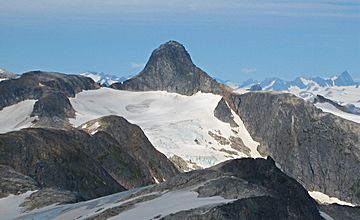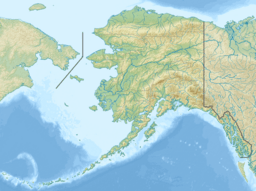Split Thumb facts for kids
Quick facts for kids Split Thumb |
|
|---|---|

Split Thumb, south aspect
|
|
| Highest point | |
| Elevation | 5,523 ft (1,683 m) |
| Prominence | 923 ft (281 m) |
| Isolation | 2.15 mi (3.46 km) |
| Parent peak | Mount Wrather |
| Geography | |
| Location | Tongass National Forest Juneau Borough Alaska, United States |
| Parent range | Coast Mountains Boundary Ranges Juneau Icefield |
| Topo map | USGS Juneau B-1 |
| Type of rock | granite |
| Climbing | |
| First ascent | July 2, 1954 |
| Easiest route | class 5.4 Southeast arête |
Split Thumb is a tall, icy mountain in Alaska, United States. It stands about 5,523 feet (1,683 meters) high. This mountain is part of the Boundary Ranges of the Coast Mountains. It is also near the southern edge of the Juneau Icefield, a huge area of ice. The mountain's unique name, "Split Thumb," was officially given in 1951.
Contents
About Split Thumb Mountain
Split Thumb is a mountain covered in glaciers. It is located in the Tongass National Forest. This is a very large forest managed by the United States government. The mountain is about 9 miles (14 km) northeast of Juneau. It is also 2.15 miles (3 km) southeast of Nugget Mountain. Heintzleman Ridge is about 4 miles (6 km) to the west.
Where is Split Thumb Located?
Split Thumb is surrounded by glaciers. The Lemon Creek Glacier is to its west. The Norris Glacier is to its east. There is also a special area of ice called the Split Thumb Icefall. This icefall is found on the eastern side of the mountain.
The First Climb to the Top
The very first time anyone successfully climbed to the top of Split Thumb was on July 2, 1954. This important climb was made by a group from the Juneau Icefield Research Project. The climbers were Edward LaChapelle, Dick Hubley, Carlton Ray, Dr. Conrad Buettner, and Bob Goodwin. They were the first to reach the summit of this icy peak.
What's the Weather Like at Split Thumb?
Split Thumb is in a subarctic climate zone. This means it has long, cold, and snowy winters. The summers are usually cool. Weather systems from the Gulf of Alaska hit the Coast Mountains. The mountains force the air upwards. This process is called orographic lift. It causes a lot of rain and snow to fall on the mountain. Temperatures can drop very low, sometimes below −20 °C. With the wind, it can feel even colder, below −30 °C. The best time to visit or climb Split Thumb is usually in July. This month often has the most pleasant weather.


